Back to the Index page
Robin Hood’s Bay 23 September 2009
led by Tom & Janet Denney, notes by Gill Smith
14 people, including one guest and one new member whom we were delighted to welcome, gathered in the car park at Robin Hood’s Bay for this trip led by Tom and Janet Denney. We walked north along the “Railway Path”
as far as Raindale, then returned via the coastal path, stopping for lunch on the clifftops overlooking the wave-cut platform, watching the tide come in. Half way along the sun broke through and the rest of the day was glorious.
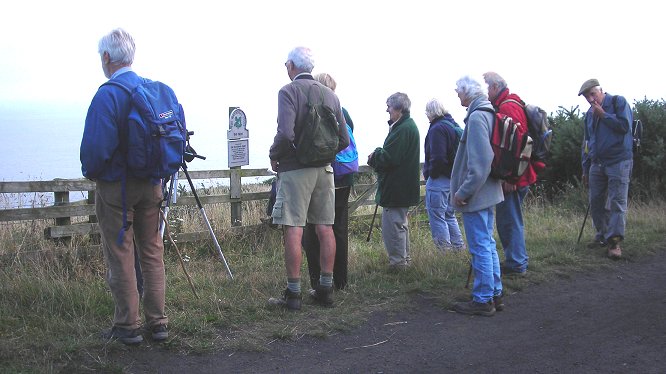
This walk was a “general interest” one, with an emphasis on birds.
Although we did not see the ring-necked parakeet that Tom had seen on a recce visit we did have good views of various species both on the land and over the sea. Tom had brought his telescope along, which meant we had stunning views of a male stonechat on a fence, a curlew on the shore and a group of young “shormorants” at the water’s edge. There was considerable debate as to whether these were shags or cormorants – I plumped for shag for at least the two all-dark adult birds which I convinced myself had yellow beaks!

At this time of year on the coast the birder always hopes that something special may turn up hiding in the bushes after struggling across the North Sea (for example on the same day Teesmouth had a red backed shrike and there were migrant warblers further down the coast). However we were not in luck, and perhaps a party of fourteen does not encourage birds to show themselves. On the other hand we did see a few swallows and house martins over the cliffs and on their way south.
Similarly, at sea September is a time when sea birds are on the move in big numbers. However to be seen from shore more unsettled weather is needed, so we had to content ourselves with viewing a solitary gannet well out to sea, a few “comic“ terns drifting south, one fulmar yet to leave for its sojourn out at sea, and a juvenile eider close inshore in the bay. [Thanks to Tom for these notes.]
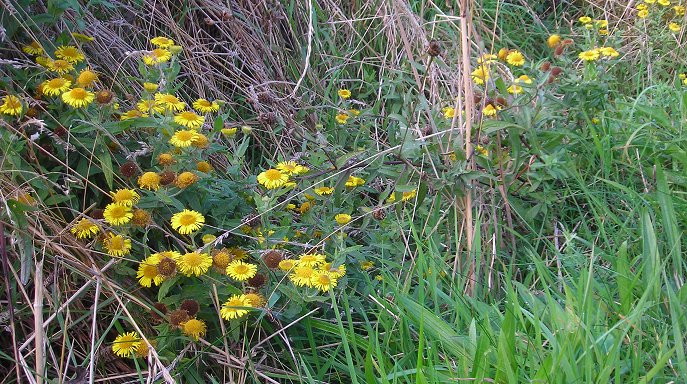
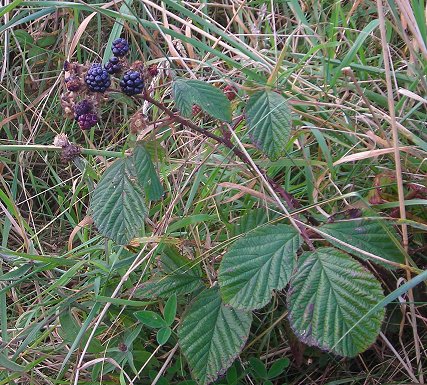 I did not make a full plant list, but did note a few particularly interesting species, such as an unusual ivy-leaved toadflax with large flowers and rounder, fleshier leaves than normal, the Erigeron seaside daisy that we never see inland, as well as fleabane (above) and hemp agrimony which are much commoner here on the coast than at home in Ryedale. We also spotted one plant of solomon’s seal along the railway (probably the hybrid and likely a garden escape, along with red valerian which was also present), wild golden rod Solidago virgaurea – and an abundance of juicy ripe blackberries....
I did not make a full plant list, but did note a few particularly interesting species, such as an unusual ivy-leaved toadflax with large flowers and rounder, fleshier leaves than normal, the Erigeron seaside daisy that we never see inland, as well as fleabane (above) and hemp agrimony which are much commoner here on the coast than at home in Ryedale. We also spotted one plant of solomon’s seal along the railway (probably the hybrid and likely a garden escape, along with red valerian which was also present), wild golden rod Solidago virgaurea – and an abundance of juicy ripe blackberries....
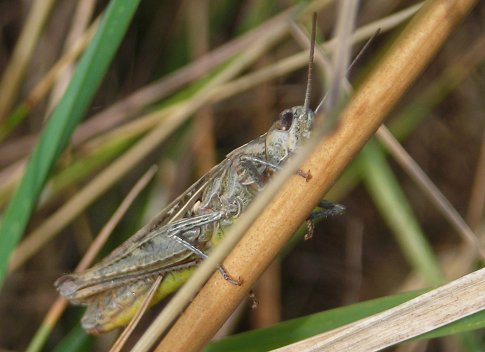 There were several butterflies around, especially after the sun came out. I spotted whites, a painted lady, small tortoiseshell, several speckled woods and a couple of peacocks (did anyone see a red admiral?).
Tom saw a dragonfly near the water-filled ditch just before Raindale – I’d hazard a guess at southern hawker. There were at least five species of hoverfly including the marmalade hoverfly Episyrphus balteatus, a Syrphus sp., an Eristalis, one that might have been Eupeodes corollae and a small, dark one that I couldn’t begin to identify. There were also several grasshoppers, probably of at least two different kinds from their songs, but I only saw this one, about an inch long.
There were several butterflies around, especially after the sun came out. I spotted whites, a painted lady, small tortoiseshell, several speckled woods and a couple of peacocks (did anyone see a red admiral?).
Tom saw a dragonfly near the water-filled ditch just before Raindale – I’d hazard a guess at southern hawker. There were at least five species of hoverfly including the marmalade hoverfly Episyrphus balteatus, a Syrphus sp., an Eristalis, one that might have been Eupeodes corollae and a small, dark one that I couldn’t begin to identify. There were also several grasshoppers, probably of at least two different kinds from their songs, but I only saw this one, about an inch long.
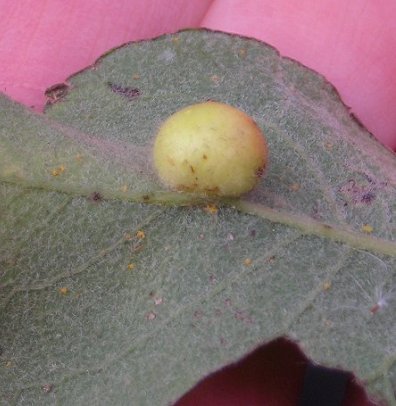 |
 |
We also saw a couple of interesting galls: a pea gall on a willow leaf (left), caused by one of the Pontania sp. gall wasps (thanks to Stuart Dunlop for this id); and knopper gall (right – photo from 2007) on the acorns of a pedunculate oak Quercus robur – this affects the developing acorn and causes the cup to make a rough, knobbly ‘lump’. Knopper galls are also caused by a tiny wasp, Andricus quercuscalicis. According to the UK Safari website (http://www.uksafari.com/galls4.htm) “Chemicals secreted by the wasp grub alters the normal cell division process and causes the oak to produce gall tissues that enclose the grubs providing both protection and food. The grubs feed on a nutritious layer of cells inside the galls.”
On the way back to the cars Janet and one or two other lucky people caught a glimpse of a harbour porpoise, perhaps two – just a fin breaking the sea surface, but exciting nonetheless.
This was a most enjoyable trip (it’s always nice to have a day by the seaside – we even bought ice-creams at the end), and we thanked Tom and Janet for organising and leading it.
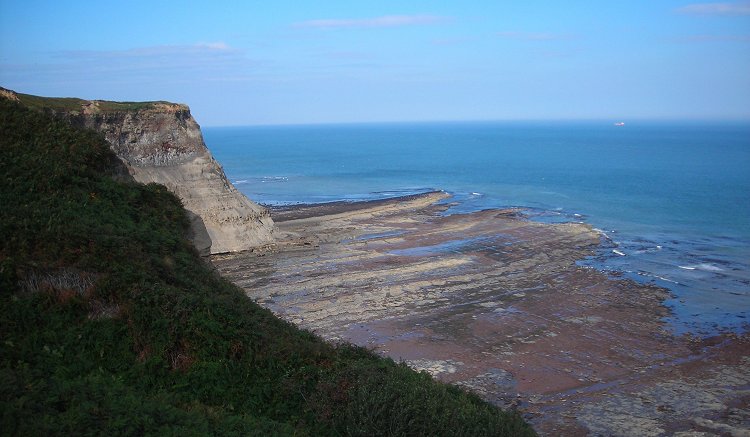
Gill Smith 2009
© Ryedale Natural History Society 2009; Photos © Gill Smith and Janet Denney 2009



 I did not make a full plant list, but did note a few particularly interesting species, such as an unusual ivy-leaved toadflax with large flowers and rounder, fleshier leaves than normal, the Erigeron seaside daisy that we never see inland, as well as fleabane (above) and hemp agrimony which are much commoner here on the coast than at home in Ryedale. We also spotted one plant of solomon’s seal along the railway (probably the hybrid and likely a garden escape, along with red valerian which was also present), wild golden rod Solidago virgaurea – and an abundance of juicy ripe blackberries....
I did not make a full plant list, but did note a few particularly interesting species, such as an unusual ivy-leaved toadflax with large flowers and rounder, fleshier leaves than normal, the Erigeron seaside daisy that we never see inland, as well as fleabane (above) and hemp agrimony which are much commoner here on the coast than at home in Ryedale. We also spotted one plant of solomon’s seal along the railway (probably the hybrid and likely a garden escape, along with red valerian which was also present), wild golden rod Solidago virgaurea – and an abundance of juicy ripe blackberries.... There were several butterflies around, especially after the sun came out. I spotted whites, a painted lady, small tortoiseshell, several speckled woods and a couple of peacocks (did anyone see a red admiral?).
Tom saw a dragonfly near the water-filled ditch just before Raindale – I’d hazard a guess at southern hawker. There were at least five species of hoverfly including the marmalade hoverfly Episyrphus balteatus, a Syrphus sp., an Eristalis, one that might have been Eupeodes corollae and a small, dark one that I couldn’t begin to identify. There were also several grasshoppers, probably of at least two different kinds from their songs, but I only saw this one, about an inch long.
There were several butterflies around, especially after the sun came out. I spotted whites, a painted lady, small tortoiseshell, several speckled woods and a couple of peacocks (did anyone see a red admiral?).
Tom saw a dragonfly near the water-filled ditch just before Raindale – I’d hazard a guess at southern hawker. There were at least five species of hoverfly including the marmalade hoverfly Episyrphus balteatus, a Syrphus sp., an Eristalis, one that might have been Eupeodes corollae and a small, dark one that I couldn’t begin to identify. There were also several grasshoppers, probably of at least two different kinds from their songs, but I only saw this one, about an inch long.

